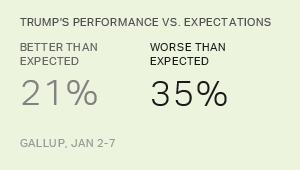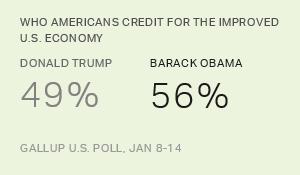Story Highlights
- Like past presidents, Trump's approval is primarily determined by party
- Race/Ethnicity and ideology also play a major role in shaping opinions
- Gender and marital status have lesser effect on Trump approval
WASHINGTON, D.C. -- Despite President Donald Trump's unconventional style, Americans' assessments of his job performance as president are largely shaped by the same familiar social fissures that have long divided U.S. public opinion -- especially party affiliation. Beyond this, Americans' political ideology and racial/ethnic identification are important factors in shaping presidential approval.

These results are based on a multivariate statistical analysis examining the relationship between key demographic or attitudinal traits and presidential approval, based on 28,947 interviews conducted Nov. 1-Dec. 30, 2017. Though this analysis focuses on the final two months of the year, examining a longer period would largely produce similar results for two reasons: Trump's approval rating was quite stable throughout 2017 and, to the extent that it has changed, it has changed in mostly similar ways across key subgroups.
While presidential approval is known to vary by party identification, race, ideology, gender and other factors, the multivariate model can help discern whether those observable differences are primarily a function of relationships of those variables to party identification, or if some have effects beyond party.
Items with a strong or moderate relationship to presidential job approval are essential for assessing the likelihood that a person will rate Trump's performance positively. For instance, knowing party affiliation alone can correctly predict over 80% of cases regarding Trump's approval rating. Political ideology, in turn, can correctly anticipate about three-fourths of the cases. Race/Ethnic identity also adds important predictive power.
Traits with a weak relationship play a secondary role in understanding Trump approval. The moderate predictors include gender, whether a person lives in a rural or low-population-density area, religiosity, marital status, age and whether a person has attended graduate school.
The following sections examine in greater detail the overall relationships between these political and demographic variables and approval of Trump.
Republicans More Likely Than Democrats to Approve of Trump, by Almost 12-to-1
Political party affiliation is the most dominant factor influencing public opinion regarding Trump's job performance. As would be expected, Republicans are very likely to approve of the president's performance, while Democrats are very unlikely to approve. In the last two months of 2017, the gap between parties on this item was 74 percentage points (81% approval among Republicans and 7% among Democrats) -- essentially on par with the average gap throughout Barack Obama's entire presidency.
| Approve | |||||||||||||||||||||||||||||||||||||||||||||||||||||||||||||||||||||||||||||||||||||||||||||||||||
|---|---|---|---|---|---|---|---|---|---|---|---|---|---|---|---|---|---|---|---|---|---|---|---|---|---|---|---|---|---|---|---|---|---|---|---|---|---|---|---|---|---|---|---|---|---|---|---|---|---|---|---|---|---|---|---|---|---|---|---|---|---|---|---|---|---|---|---|---|---|---|---|---|---|---|---|---|---|---|---|---|---|---|---|---|---|---|---|---|---|---|---|---|---|---|---|---|---|---|---|
| % | |||||||||||||||||||||||||||||||||||||||||||||||||||||||||||||||||||||||||||||||||||||||||||||||||||
| Republicans | 81 | ||||||||||||||||||||||||||||||||||||||||||||||||||||||||||||||||||||||||||||||||||||||||||||||||||
| Independents, lean Republican | 71 | ||||||||||||||||||||||||||||||||||||||||||||||||||||||||||||||||||||||||||||||||||||||||||||||||||
| Independents, no lean | 26 | ||||||||||||||||||||||||||||||||||||||||||||||||||||||||||||||||||||||||||||||||||||||||||||||||||
| Independents, lean Democratic | 8 | ||||||||||||||||||||||||||||||||||||||||||||||||||||||||||||||||||||||||||||||||||||||||||||||||||
| Democrats | 7 | ||||||||||||||||||||||||||||||||||||||||||||||||||||||||||||||||||||||||||||||||||||||||||||||||||
| Aggregated results | |||||||||||||||||||||||||||||||||||||||||||||||||||||||||||||||||||||||||||||||||||||||||||||||||||
| GALLUP, Nov. 1-Dec. 30, 2017 | |||||||||||||||||||||||||||||||||||||||||||||||||||||||||||||||||||||||||||||||||||||||||||||||||||
The approval gap is less extreme for independents who lean toward the Republican Party. A strong majority of independents who lean Republican approve of Trump (71%), 10 points below outright Republicans' approval rating.
The very low approval rating among independents who lean Democratic, meanwhile, is essentially the same rate as committed Democrats. Only about a quarter of "pure" independents (i.e., do not lean toward either party) approve of Trump.
Other Important Indicators Are Ideology and Race/Ethnicity
Ideology is also a key predictor of Trump approval. Nearly seven in 10 conservatives (67%) approve of Trump's job performance. His approval rating falls steeply among politically moderate individuals; about three in 10 give the president positive job reviews. Ten percent of liberals approve of the president.
Ideology, of course, is strongly tied to party affiliation but has an independent effect within party groups. Conservative Republicans are notably more supportive than liberal and moderate Republicans. Similarly, liberal Democrats assess Trump's job performance slightly more harshly than moderate Democrats do, and significantly more harshly than conservative Democrats do.
| U.S. adults | Republicans | Democrats | |||||||||||||||||||||||||||||||||||||||||||||||||||||||||||||||||||||||||||||||||||||||||||||||||
|---|---|---|---|---|---|---|---|---|---|---|---|---|---|---|---|---|---|---|---|---|---|---|---|---|---|---|---|---|---|---|---|---|---|---|---|---|---|---|---|---|---|---|---|---|---|---|---|---|---|---|---|---|---|---|---|---|---|---|---|---|---|---|---|---|---|---|---|---|---|---|---|---|---|---|---|---|---|---|---|---|---|---|---|---|---|---|---|---|---|---|---|---|---|---|---|---|---|---|---|
| % | % | % | |||||||||||||||||||||||||||||||||||||||||||||||||||||||||||||||||||||||||||||||||||||||||||||||||
| Conservatives | 67 | 88 | 18 | ||||||||||||||||||||||||||||||||||||||||||||||||||||||||||||||||||||||||||||||||||||||||||||||||
| Moderates | 29 | 66 | 8 | ||||||||||||||||||||||||||||||||||||||||||||||||||||||||||||||||||||||||||||||||||||||||||||||||
| Liberals | 10 | 58 | 3 | ||||||||||||||||||||||||||||||||||||||||||||||||||||||||||||||||||||||||||||||||||||||||||||||||
| Aggregated results | |||||||||||||||||||||||||||||||||||||||||||||||||||||||||||||||||||||||||||||||||||||||||||||||||||
| GALLUP, Nov. 1-Dec. 30, 2017 | |||||||||||||||||||||||||||||||||||||||||||||||||||||||||||||||||||||||||||||||||||||||||||||||||||
Race is also a highly salient factor in shaping opinions of Trump's job performance, as explored in a previous Â鶹´«Ã½AV analysis. In particular, Trump fares poorly with nonwhite Americans -- 16% approved of the president in the last two months of 2017, compared with 47% of white Americans -- though he is underwater with both groups.
| U.S. adults | Republicans | Democrats | |||||||||||||||||||||||||||||||||||||||||||||||||||||||||||||||||||||||||||||||||||||||||||||||||
|---|---|---|---|---|---|---|---|---|---|---|---|---|---|---|---|---|---|---|---|---|---|---|---|---|---|---|---|---|---|---|---|---|---|---|---|---|---|---|---|---|---|---|---|---|---|---|---|---|---|---|---|---|---|---|---|---|---|---|---|---|---|---|---|---|---|---|---|---|---|---|---|---|---|---|---|---|---|---|---|---|---|---|---|---|---|---|---|---|---|---|---|---|---|---|---|---|---|---|---|
| % | % | % | |||||||||||||||||||||||||||||||||||||||||||||||||||||||||||||||||||||||||||||||||||||||||||||||||
| Non-Hispanic whites | 47 | 83 | 9 | ||||||||||||||||||||||||||||||||||||||||||||||||||||||||||||||||||||||||||||||||||||||||||||||||
| Nonwhites | 16 | 59 | 5 | ||||||||||||||||||||||||||||||||||||||||||||||||||||||||||||||||||||||||||||||||||||||||||||||||
| Aggregated results | |||||||||||||||||||||||||||||||||||||||||||||||||||||||||||||||||||||||||||||||||||||||||||||||||||
| GALLUP, Nov. 1-Dec. 30, 2017 | |||||||||||||||||||||||||||||||||||||||||||||||||||||||||||||||||||||||||||||||||||||||||||||||||||
Disaggregating the umbrella "nonwhite" category shows that Trump is especially unpopular with black Americans, 9% of whom approve of how he handles his job. About one in five Hispanics (18%) approve of Trump's performance, while 30% of Americans who identify as Asian or another nonwhite race/ethnicity approve of the president.
Racial/Ethnic identification plays a role in shaping presidential approval, even when considering party identification. For example, 83% of white Republicans approve of Trump, compared with 59% of nonwhite Republicans.
Gender and Marital Status Have Weak Effect on Approval
The traditional political gender gap is very much evident in assessing Trump's performance. This gap continued in the last two months of 2017, with 43% of men approving of the president compared with 31% of women. This gap is mostly explained by the tendency for men to identify as Republicans and women as Democrats -- but within both partisan groups, men are slightly more likely than women to approve of the president.
| U.S. adults | Republicans | Democrats | |||||||||||||||||||||||||||||||||||||||||||||||||||||||||||||||||||||||||||||||||||||||||||||||||
|---|---|---|---|---|---|---|---|---|---|---|---|---|---|---|---|---|---|---|---|---|---|---|---|---|---|---|---|---|---|---|---|---|---|---|---|---|---|---|---|---|---|---|---|---|---|---|---|---|---|---|---|---|---|---|---|---|---|---|---|---|---|---|---|---|---|---|---|---|---|---|---|---|---|---|---|---|---|---|---|---|---|---|---|---|---|---|---|---|---|---|---|---|---|---|---|---|---|---|---|
| % | % | % | |||||||||||||||||||||||||||||||||||||||||||||||||||||||||||||||||||||||||||||||||||||||||||||||||
| Men | 43 | 83 | 10 | ||||||||||||||||||||||||||||||||||||||||||||||||||||||||||||||||||||||||||||||||||||||||||||||||
| Women | 31 | 78 | 5 | ||||||||||||||||||||||||||||||||||||||||||||||||||||||||||||||||||||||||||||||||||||||||||||||||
| Aggregated results | |||||||||||||||||||||||||||||||||||||||||||||||||||||||||||||||||||||||||||||||||||||||||||||||||||
| GALLUP, Nov. 1-Dec. 30, 2017 | |||||||||||||||||||||||||||||||||||||||||||||||||||||||||||||||||||||||||||||||||||||||||||||||||||
Trump's approval rating is also divided by marital status, with 44% of married adults approving of the president compared with 29% of unmarried adults. Prior Â鶹´«Ã½AV research has noted the growing importance of marriage in determining party identification, with married adults showing a greater tendency than unmarried adults to identify as Republican. But even when looking just at Republicans, married adults remain somewhat more positive than unmarried adults in terms of presidential approval. This difference, however, does not exist between married and unmarried Democrats.
| U.S. adults | Republicans | Democrats | |||||||||||||||||||||||||||||||||||||||||||||||||||||||||||||||||||||||||||||||||||||||||||||||||
|---|---|---|---|---|---|---|---|---|---|---|---|---|---|---|---|---|---|---|---|---|---|---|---|---|---|---|---|---|---|---|---|---|---|---|---|---|---|---|---|---|---|---|---|---|---|---|---|---|---|---|---|---|---|---|---|---|---|---|---|---|---|---|---|---|---|---|---|---|---|---|---|---|---|---|---|---|---|---|---|---|---|---|---|---|---|---|---|---|---|---|---|---|---|---|---|---|---|---|---|
| % | % | % | |||||||||||||||||||||||||||||||||||||||||||||||||||||||||||||||||||||||||||||||||||||||||||||||||
| Married | 44 | 84 | 7 | ||||||||||||||||||||||||||||||||||||||||||||||||||||||||||||||||||||||||||||||||||||||||||||||||
| Unmarried | 29 | 75 | 7 | ||||||||||||||||||||||||||||||||||||||||||||||||||||||||||||||||||||||||||||||||||||||||||||||||
| Aggregated results | |||||||||||||||||||||||||||||||||||||||||||||||||||||||||||||||||||||||||||||||||||||||||||||||||||
| GALLUP, Nov. 1-Dec. 30, 2017 | |||||||||||||||||||||||||||||||||||||||||||||||||||||||||||||||||||||||||||||||||||||||||||||||||||
The remainder of the weak variables are also well-known dividing lines in American society -- religiosity, living in a rural or urban area, education and age. The table below shows Trump's approval rating among each of these groups in the last two months of 2017, as well as Trump's rating within each group after taking party into account. (Note: In the table below, "low-density" county refers to those counties whose population density falls in the bottom 40% of all counties.)
| U.S. adults | Republicans | Democrats | ||||||||||||||||||||||||||||||||||||||||||||||||||||||||||||||||||||||||||||||||||||||||||||||||||
|---|---|---|---|---|---|---|---|---|---|---|---|---|---|---|---|---|---|---|---|---|---|---|---|---|---|---|---|---|---|---|---|---|---|---|---|---|---|---|---|---|---|---|---|---|---|---|---|---|---|---|---|---|---|---|---|---|---|---|---|---|---|---|---|---|---|---|---|---|---|---|---|---|---|---|---|---|---|---|---|---|---|---|---|---|---|---|---|---|---|---|---|---|---|---|---|---|---|---|---|---|
| % | % | % | ||||||||||||||||||||||||||||||||||||||||||||||||||||||||||||||||||||||||||||||||||||||||||||||||||
| Type of county | ||||||||||||||||||||||||||||||||||||||||||||||||||||||||||||||||||||||||||||||||||||||||||||||||||||
| Lives in low-density county | 47 | 85 | 11 | |||||||||||||||||||||||||||||||||||||||||||||||||||||||||||||||||||||||||||||||||||||||||||||||||
| Lives in non-low-density county | 30 | 76 | 5 | |||||||||||||||||||||||||||||||||||||||||||||||||||||||||||||||||||||||||||||||||||||||||||||||||
| Religiosity | ||||||||||||||||||||||||||||||||||||||||||||||||||||||||||||||||||||||||||||||||||||||||||||||||||||
| Highly religious | 46 | 82 | 9 | |||||||||||||||||||||||||||||||||||||||||||||||||||||||||||||||||||||||||||||||||||||||||||||||||
| Moderately religious | 37 | 81 | 6 | |||||||||||||||||||||||||||||||||||||||||||||||||||||||||||||||||||||||||||||||||||||||||||||||||
| Not religious | 25 | 74 | 4 | |||||||||||||||||||||||||||||||||||||||||||||||||||||||||||||||||||||||||||||||||||||||||||||||||
| Age | ||||||||||||||||||||||||||||||||||||||||||||||||||||||||||||||||||||||||||||||||||||||||||||||||||||
| 18-29 | 25 | 67 | 6 | |||||||||||||||||||||||||||||||||||||||||||||||||||||||||||||||||||||||||||||||||||||||||||||||||
| 30-49 | 35 | 79 | 6 | |||||||||||||||||||||||||||||||||||||||||||||||||||||||||||||||||||||||||||||||||||||||||||||||||
| 50-64 | 42 | 82 | 7 | |||||||||||||||||||||||||||||||||||||||||||||||||||||||||||||||||||||||||||||||||||||||||||||||||
| 65+ | 46 | 88 | 9 | |||||||||||||||||||||||||||||||||||||||||||||||||||||||||||||||||||||||||||||||||||||||||||||||||
| Education | ||||||||||||||||||||||||||||||||||||||||||||||||||||||||||||||||||||||||||||||||||||||||||||||||||||
| Did not attend graduate school | 38 | 81 | 8 | |||||||||||||||||||||||||||||||||||||||||||||||||||||||||||||||||||||||||||||||||||||||||||||||||
| Attended graduate school | 30 | 76 | 2 | |||||||||||||||||||||||||||||||||||||||||||||||||||||||||||||||||||||||||||||||||||||||||||||||||
| Aggregated results | ||||||||||||||||||||||||||||||||||||||||||||||||||||||||||||||||||||||||||||||||||||||||||||||||||||
| GALLUP, Nov. 1-Dec. 30, 2017 | ||||||||||||||||||||||||||||||||||||||||||||||||||||||||||||||||||||||||||||||||||||||||||||||||||||
Bottom Line
Trump pledged to be a disruptive force as president, one not bound to traditional political alliances or considerations. However, Trump's support seems subject to the same forces that have historically shaped public opinion in the U.S. -- one's party identification and, to a lesser extent, their race and ideology.
Though Trump is generally an unpopular president, he is well-liked by an overwhelming majority of Republicans -- which is sometimes seen as his greatest political strength, particularly when dealing with congressional Republicans, who are not as popular among their own GOP base. While Trump's popularity among his base can be a source of political strength for the president, it may also mask his central political weakness.
Currently, Trump relies heavily on Republicans and political conservatives for support, with some additional support coming from Americans who may share certain cultural or demographic backgrounds. Though this support has been stable over the past year, it is limited, giving Trump the lowest first-year approval ratings of any elected president in polling history. If that support is to expand, it will largely require attracting Americans of different political or demographic backgrounds, something that Trump has found very difficult to do up until now.
Survey Methods
Results for this Â鶹´«Ã½AV poll are based on telephone interviews conducted Nov. 1-Dec. 30, 2017, on the Â鶹´«Ã½AV U.S. Daily survey, with a random sample of 28,947 adults, aged 18 and older, living in all 50 U.S. states and the District of Columbia. For results based on the total sample of national adults, the margin of sampling error is ±1 percentage point at the 95% confidence level. All reported margins of sampling error include computed design effects for weighting.
Each sample of national adults includes a minimum quota of 70% cellphone respondents and 30% landline respondents, with additional minimum quotas by time zone within region. Landline and cellular telephone numbers are selected using random-digit-dial methods.
Learn more about how works.





